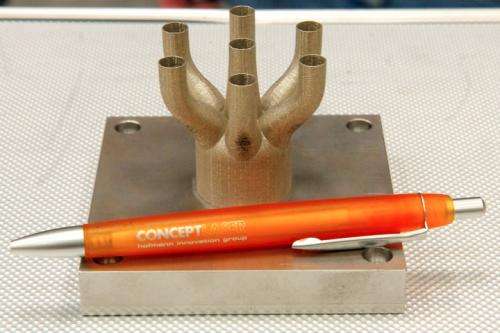NASA's space launch system using futuristic technology to build the next generation of rockets

(Phys.org)—NASA's Marshall Space Flight Center in Huntsville, Ala. is using a method called selective laser melting, or SLM, to create intricate metal parts for America's next heavy-lift rocket. Using this state-of-the-art technique will benefit the agency by saving millions in manufacturing costs.
NASA is building the Space Launch System or SLS—a rocket managed at the Marshall Center and designed to take humans, equipment and experiments beyond low Earth orbit to nearby asteroids and eventually to Mars.
SLM is similar to 3-D printing and is the future of manufacturing.
"Basically, this machine takes metal powder and uses a high-energy laser to melt it in a designed pattern," says Ken Cooper, advanced manufacturing team lead at the Marshall Center. "The laser will layer the melted dust to fuse whatever part we need from the ground up, creating intricate designs. The process produces parts with complex geometries and precise mechanical properties from a three-dimensional computer-aided design."
There are two major benefits to this process, which are major considerations for the Space Launch System Program: savings and safety.
"This process significantly reduces the manufacturing time required to produce parts from months to weeks or even days in some cases," said Andy Hardin, the integration hardware lead for the Engines Office in SLS. "It's a significant improvement in affordability, saving both time and money. Also, since we're not welding parts together, the parts are structurally stronger and more reliable, which creates an overall safer vehicle."
The emerging technology will build parts for America's next flagship rocket more affordably and efficiently, while increasing the safety of astronauts and the workforce. Some of the "printed" engine parts will be structurally tested and used in hot-fire tests of a J-2X engine later this year. The J-2X will be used as the upper stage engine for the SLS.
The goal is to use selective laser melting to manufacture parts on the first SLS test flight in 2017.
The agency procured the M2 Cusing machine, built by Concept Laser—a division of Hoffman Innovation Group of Lichtenfels, Germany to perform the selective-laser-manufacturing.
Watch video of the SLM machine and see it in action:
Provided by NASA




















